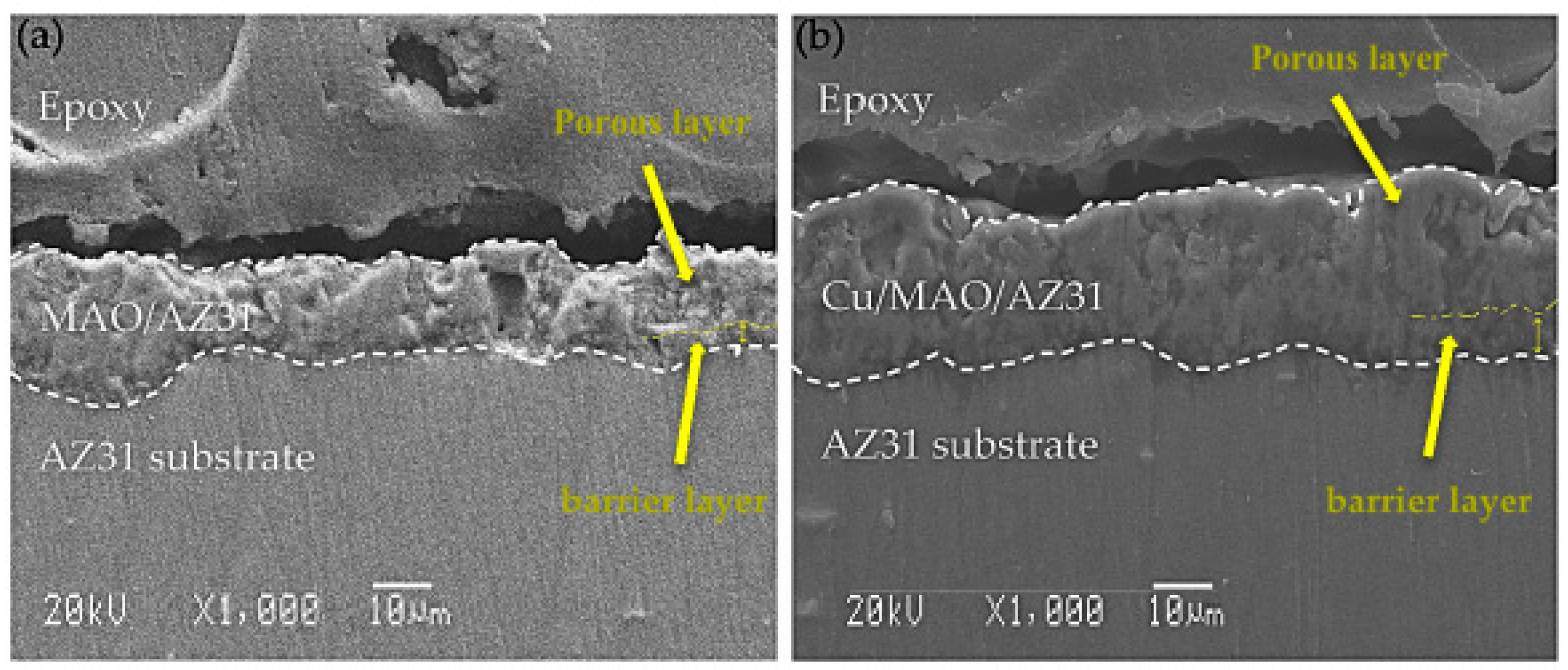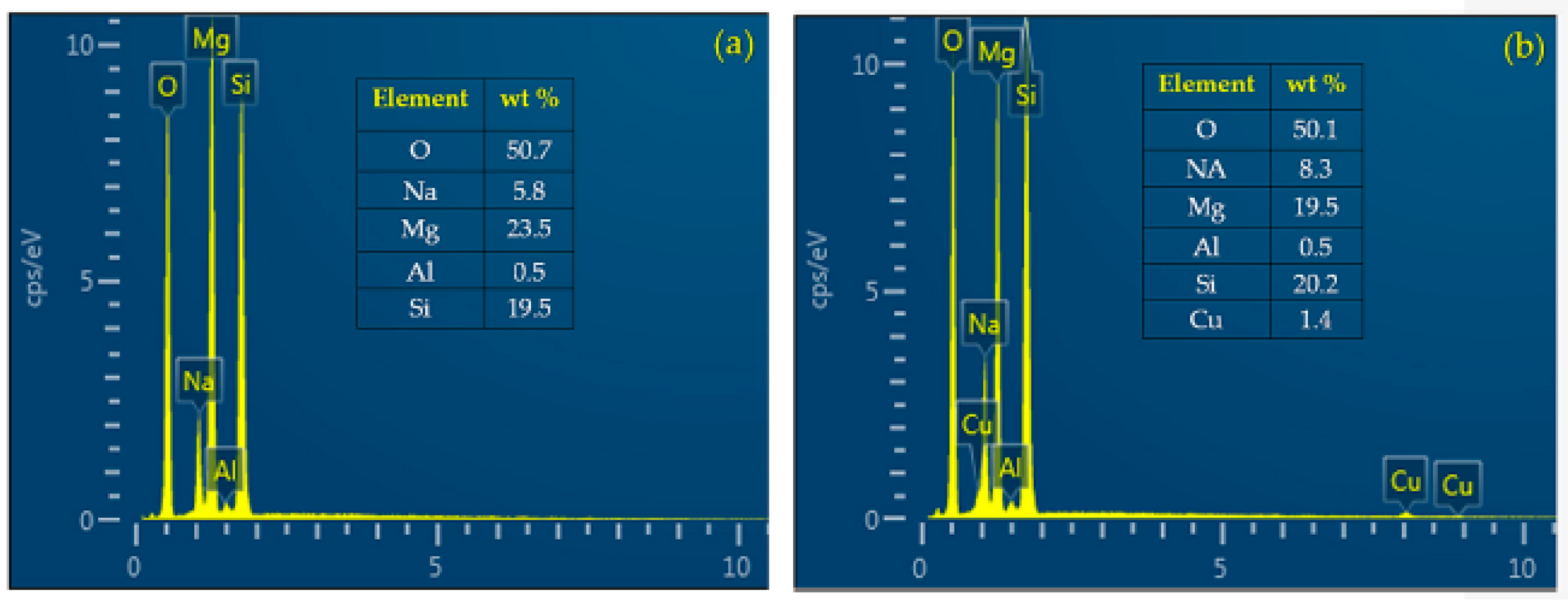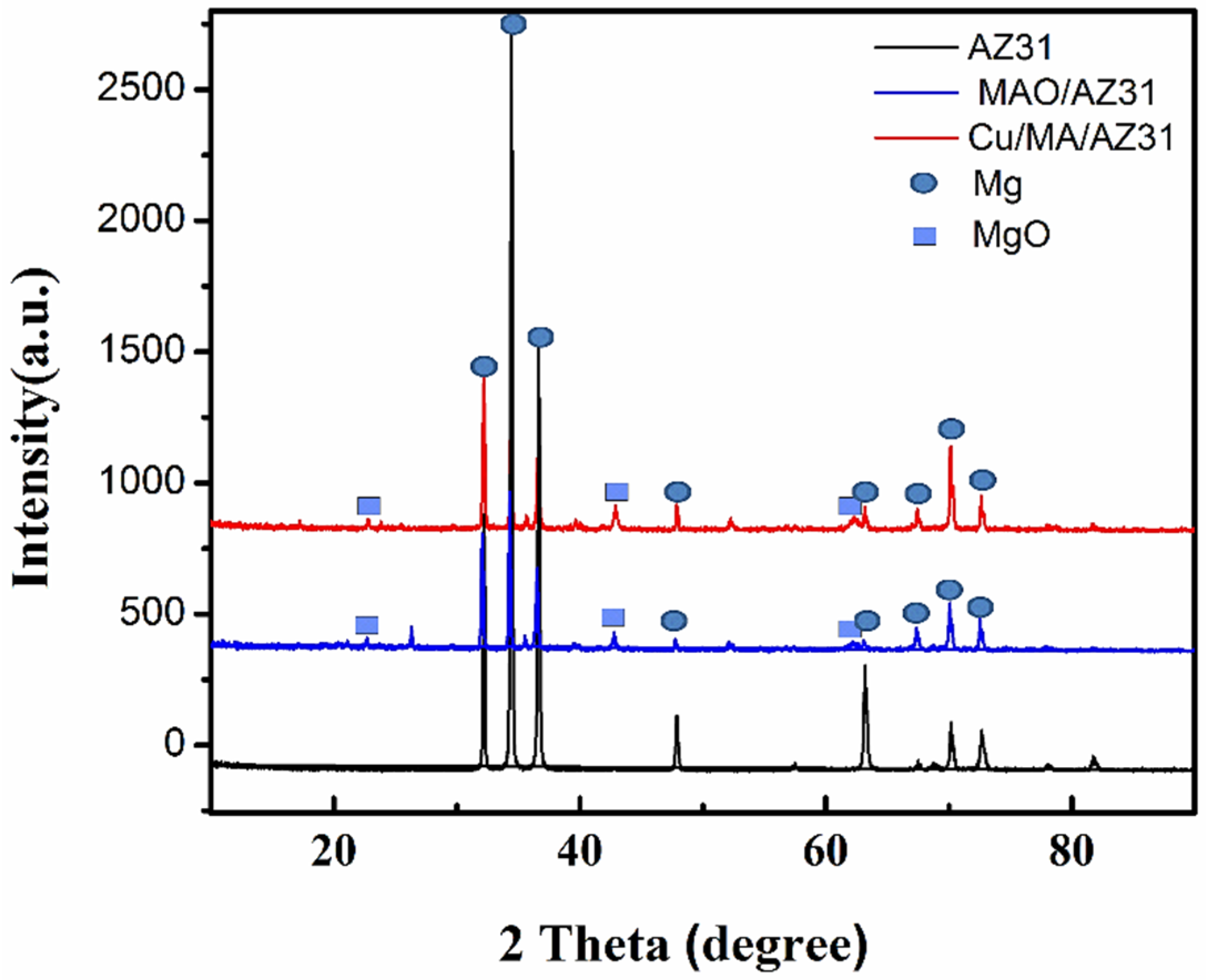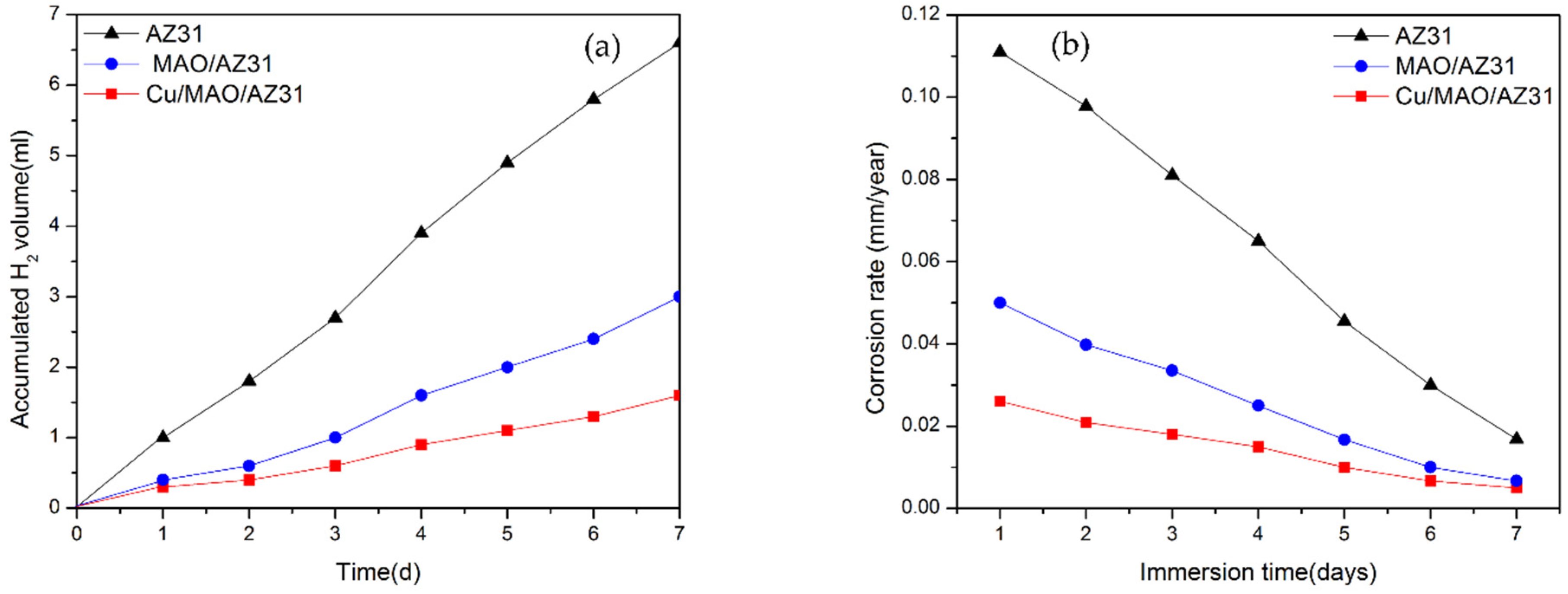Influence of Cu2+ Ions on the Corrosion Resistance of AZ31 Magnesium Alloy with Microarc Oxidation
Abstract
:1. Introduction
2. Materials and Methods
2.1. Specimen and MAO Preparation
2.2. Coating Characterization
2.3. Corrosion Behavior Test
2.3.1. Electrochemical Measurements
2.3.2. Long-Term Period Immersion Test
2.4. Cell Viability Test and Cell Morphology Examination
3. Results and Discussion
3.1. Sample Characterization
3.2. Corrosion Analysis
3.2.1. Electrochemical Test
3.2.2. H2 Evolution Test
3.3. Cytotoxicity Test
4. Conclusions
- The Cu-free electrolyte consisting of EDTA and Na2SiO3 resulted in a MgO-containing coating (MAO/AZ31). The Cu-containing electrolyte comprising EDTA, Na2SiO3, and Cu (CH3COO)2 led to a Cu2+-containing coating (Cu/MAO/AZ31). The porosity in MAO/AZ31 increased in quantity with wide pores, but the thickness decreased. By contrast, Cu/MAO/AZ31 showed minimal pores with an increased thickness.
- Electrochemical measurements and the H2 evolution test showed that the corrosion rate of Cu/MAO/AZ31 decreased compared with that of MAO/AZ31. Additionally, there will be a decrease in the rate of degradation on the AZ31 Mg alloy.
- In vitro cytotoxicity examination of Cu/MAO/AZ31 confirmed that a cytotoxic reaction to L-929 cells was not induced; however, cell proliferation was established during the first 4 days. Further research is needed for clinical applications.
- These observations indicated that the Cu2+-coated AZ31 Mg alloy has excellent corrosion resistance and cytocompatibility, giving it the potential to be used as a medical implant material such as miniplates for the purpose of skeletal anchorage.
Author Contributions
Funding
Acknowledgments
Conflicts of Interest
References
- Witte, F. The history of biodegradable magnesium implants: A review. Acta Biomater. 2010, 6, 1680–1692. [Google Scholar] [CrossRef] [PubMed]
- Zhang, L.; Zhang, J.; Chen, C.-F.; Gu, Y. Advances in microarc oxidation coated AZ31 Mg alloys for biomedical applications. Corros. Sci. 2015, 91, 7–28. [Google Scholar] [CrossRef]
- Chen, Q.; Thouas, G.A. Metallic implant biomaterials. Mater. Sci. Eng. R Rep. 2015, 87, 1–57. [Google Scholar] [CrossRef]
- Lin, B.; Zhong, M.; Zheng, C.; Cao, L.; Wang, D.; Wang, L.; Liang, J.; Cao, B. Preparation and characterization of dopamine-induced biomimetic hydroxyapatite coatings on the AZ31 magnesium alloy. Surf. Coat. Technol. 2015, 281, 82–88. [Google Scholar] [CrossRef]
- Peron, M.; Torgersen, J.; Solberg, K. Mg and Its Alloys for Biomedical Applications: Exploring Corrosion and Its Interplay with Mechanical Failure. Metals 2017, 7, 252. [Google Scholar] [CrossRef] [Green Version]
- Zhu, B.; Xu, Y.; Sun, J.; Yang, L.; Guo, C.; Liang, J.; Cao, B. Preparation and Characterization of Aminated Hydroxyethyl Cellulose-Induced Biomimetic Hydroxyapatite Coatings on the AZ31 Magnesium Alloy. Metals 2017, 7, 214. [Google Scholar] [CrossRef] [Green Version]
- Tian, P.; Liu, X. Surface modification of biodegradable magnesium and its alloys for biomedical applications. Regen. Biomater. 2015, 2, 135–151. [Google Scholar] [CrossRef] [PubMed] [Green Version]
- Wang, S.; Fu, L.; Nai, Z.; Liang, J.; Cao, B. Comparison of Corrosion Resistance and Cytocompatibility of MgO and ZrO2 Coatings on AZ31 Magnesium Alloy Formed via Plasma Electrolytic Oxidation. Coatings 2018, 8, 441. [Google Scholar] [CrossRef] [Green Version]
- Witte, F.; Kaese, V.; Haferkamp, H.; Switzer, E.; Meyer-Lindenberg, A.; Wirth, C.; Windhagen, H. In vivo corrosion of four magnesium alloys and the associated bone response. Biomaterials 2005, 26, 3557–3563. [Google Scholar] [CrossRef] [PubMed]
- Chaya, A.; Yoshizawa-Smith, S.; Verdelis, K.; Myers, N.; Costello, B.J.; Chou, D.-T.; Pal, S.; Maiti, S.; Kumta, P.N.; Sfeir, C. In vivo study of magnesium plate and screw degradation and bone fracture healing. Acta Biomater. 2015, 18, 262–269. [Google Scholar] [CrossRef] [PubMed]
- Al-Dumaini, A.A.; Halboub, E.; Alhammadi, M.S.; Ishaq, R.A.R.; Youssef, M. A novel approach for treatment of skeletal Class II malocclusion: Miniplates-based skeletal anchorage. Am. J. Orthod. Dentofac. Orthop. 2018, 153, 239–247. [Google Scholar] [CrossRef] [PubMed]
- Lu, Y.; Zhang, Y.; Cong, M.; Li, X.; Xu, W.; Song, L. Microstructures, Mechanical and Corrosion Properties of the Extruded AZ31-xCaO Alloys. Materials 2018, 11, 1467. [Google Scholar] [CrossRef] [PubMed] [Green Version]
- Narayanan, T.S.; Park, I.S.; Lee, M.H. Strategies to improve the corrosion resistance of microarc oxidation (MAO) coated magnesium alloys for degradable implants: Prospects and challenges. Prog. Mater. Sci. 2014, 60, 1–71. [Google Scholar] [CrossRef]
- Shahar, I.; Hosaka, T.; Yoshihara, S.; Macdonald, B. Mechanical and Corrosion Properties of AZ31 Mg Alloy Processed by Equal-Channel Angular Pressing and Aging. Procedia Eng. 2017, 184, 423–431. [Google Scholar] [CrossRef]
- Hornberger, H.; Virtanen, S.; Boccaccini, A. Biomedical coatings on magnesium alloys–A review. Acta Biomater. 2012, 8, 2442–2455. [Google Scholar] [CrossRef] [PubMed]
- Arrabal, R.; Mota, J.M.; Criado, A.; Pardo, A.; Mohedano, M.; Matykina, E. Assessment of duplex coating combining plasma electrolytic oxidation and polymer layer on AZ31 magnesium alloy. Surf. Coat. Technol. 2012, 206, 4692–4703. [Google Scholar] [CrossRef]
- Razavi, M.; Fathi, M.; Savabi, O.; Vashaee, D.; Tayebi, L. In vivo study of nanostructured akermanite/ PEO coating on biodegradable magnesium alloy for biomedical applications. J. Biomed. Mater. Res. Part A 2015, 103, 1798–1808. [Google Scholar] [CrossRef] [PubMed]
- Razavi, M.; Fathi, M.; Savabi, O.; Vashaee, D.; Tayebi, L. In vivo biocompatibility of Mg implants surface modified by nanostructured merwinite/PEO. J. Mater. Sci. Mater. Electron. 2015, 26, 184. [Google Scholar] [CrossRef]
- White, L.; Koo, Y.; Neralla, S.; Sankar, J.; Huang, N. Enhanced mechanical properties and increased corrosion resistance of a biodegradable magnesium alloy by plasma electrolytic oxidation (PEO). Mater. Sci. Eng. B 2016, 208, 39–46. [Google Scholar] [CrossRef] [Green Version]
- Liu, C.; Fu, X.; Pan, H.; Wan, P.; Wang, L.; Tan, L.; Wang, K.; Zhao, Y.; Yang, K.; Chu, P.K. Biodegradable Mg-Cu alloys with enhanced osteogenesis, angiogenesis, and long-lasting antibacterial effects. Sci. Rep. 2016, 6, 27374. [Google Scholar] [CrossRef]
- Rtimi, S.; Baghriche, O.; Lavanchy, J.; Kiwi, J. Growth of TiO2/Cu films by HiPIMS for accelerated bacterial loss of viability. Surf. Coat. Technol. 2013, 232, 804–813. [Google Scholar] [CrossRef] [Green Version]
- Wu, H.; Zhang, X.; Geng, Z.; Yin, Y.; Hang, R.; Huang, X.; Yao, X.; Tang, B. Preparation, antibacterial effects and corrosion resistant of porous Cu–TiO2 coatings. Appl. Surf. Sci. 2014, 308, 43–49. [Google Scholar] [CrossRef]
- Jayasinghe, S.B.; Caruso, J.A. Preliminary investigation of Cu-containing proteins in seeds of Brazil nuts by ICPMS and MALDI-MS methods. Int. J. Mass Spectrom. 2013, 356, 33–36. [Google Scholar] [CrossRef]
- Harris, E.D. Basic and clinical aspects of copper. Crit. Rev. Clin. Lab. Sci. 2003, 40, 547–586. [Google Scholar] [CrossRef] [PubMed]
- Harris, E.D. A requirement for copper in angiogenesis. Nutr. Rev. 2004, 62, 60–64. [Google Scholar] [CrossRef]
- Van Phuong, N.; Park, M.-S.; Yim, C.D.; You, B.S.; Moon, S. Electrodeposition of copper on AZ91 Mg alloy in cyanide solution. 한국표면공학회지 2016, 49, 238–244. [Google Scholar]
- Nguyen, V.P.; Park, M.-S.; Yim, C.D.; You, B.S.; Moon, S. Effect of Zincate Treatment of As-Cast AZ91 Mg Alloy on Electrodeposition of Copper in a Copper Pyrophosphate Bath. J. Korean Inst. Surf. Eng. 2016, 49, 401–407. [Google Scholar] [CrossRef]
- Tang, J.; Azumi, K. Effect of Copper Pretreatment on the Zincate Process and Subsequent Copper Electrodeposition of AZ31 Magnesium Alloy. J. Electrochem. Soc. 2011, 158, D535. [Google Scholar] [CrossRef] [Green Version]
- Zhu, P.; Wang, L.Y.; Chen, Y.; Zhou, M.; Zhou, J. Electrodeposition of copper coating on AZ31 magnesium alloy. Surf. Eng. 2012, 28, 796–799. [Google Scholar] [CrossRef]
- Van Phuong, N.; Park, M.-S.; Yim, C.D.; You, B.S.; Moon, S. Corrosion protection utilizing Ag layer on Cu coated AZ31 Mg alloy. Corros. Sci. 2018, 136, 201–209. [Google Scholar] [CrossRef]
- Zaki, M.H.M.; Mohd, Y.; Isa, N.N.C. Cu-Ni Alloys Coatings for Corrosion Protection on Mild Steel in 0.5 M NaCl Solution. Sci. Lett. 2017, 11, 2. [Google Scholar]
- Kamil, M.P.; Kaseem, M.; Ko, Y. Soft plasma electrolysis with complex ions for optimizing electrochemical performance. Sci. Rep. 2017, 7, 44458. [Google Scholar] [CrossRef] [PubMed]
- Chen, J.; Zhang, Y.; Ibrahim, M.; Etim, I.P.; Tan, L.; Yang, K. In vitro degradation and antibacterial property of a copper-containing micro-arc oxidation coating on Mg-2Zn-1Gd-0.5Zr alloy. Colloids Surfaces B Biointerfaces 2019, 179, 77–86. [Google Scholar] [CrossRef] [PubMed]
- Kokubo, T.; Takadama, H. How useful is SBF in predicting in vivo bone bioactivity? Biomaterials 2006, 27, 2907–2915. [Google Scholar] [CrossRef] [PubMed]
- Song, G.-L.; Atrens, A. Understanding Magnesium Corrosion—A Framework for Improved Alloy Performance. Adv. Eng. Mater. 2003, 5, 837–858. [Google Scholar] [CrossRef]
- Zhuang, J.; Guo, Y.; Xiang, N.; Xiong, Y.; Hu, Q.; Song, R. A study on microstructure and corrosion resistance of ZrO2-containing PEO coatings formed on AZ31 Mg alloy in phosphate-based electrolyte. Appl. Surf. Sci. 2015, 357, 1463–1471. [Google Scholar] [CrossRef]
- Gawel, L.; Nieuzyla, L.; Nawrat, G.; Darowicki, K.; Slepski, P. Impedance monitoring of corrosion degradation of plasma electrolytic oxidation coatings (PEO) on magnesium alloy. J. Alloy. Compd. 2017, 722, 406–413. [Google Scholar] [CrossRef]
- Tang, M.; Liu, H.; Li, W.; Zhu, L. Effect of zirconia sol in electrolyte on the characteristics of microarc oxidation coating on AZ91D magnesium. Mater. Lett. 2011, 65, 413–415. [Google Scholar] [CrossRef]
- Patake, V.; Joshi, S.; Lokhande, C.; Joo, O.-S. Electrodeposited porous and amorphous copper oxide film for application in supercapacitor. Mater. Chem. Phys. 2009, 114, 6–9. [Google Scholar] [CrossRef]
- Zhang, X.; Zhou, J.; Dou, W.; Wang, J.; Mu, X.; Zhang, Y.; Abas, A.; Su, Q.; Lan, W.; Xie, E.; et al. Room-temperature vertically-aligned copper oxide nanoblades synthesized by electrochemical restructuring of copper hydroxide nanorods: An electrode for high energy density hybrid device. J. Power Sources 2018, 383, 124–132. [Google Scholar] [CrossRef]
- Abas, A.; Sheng, H.; Ma, Y.; Zhang, X.; Wei, Y.; Su, Q.; Lan, W.; Xie, E. PEDOT:PSS coated CuO nanowire arrays grown on Cu foam for high-performance supercapacitor electrodes. J. Mater. Sci. Mater. Electron. 2019, 30, 10953–10960. [Google Scholar] [CrossRef]
- Lin, H.-H. Characterizing well-ordered CuO nanofibrils synthesized through gas-solid reactions. J. Appl. Phys. 2004, 95, 5889–5895. [Google Scholar] [CrossRef]
- Rokosz, K.; Hryniewicz, T.; Matýsek, D.; Raaen, S.; Valíček, J.; Dudek, Ł.; Harničárová, M. SEM, EDS and XPS Analysis of the Coatings Obtained on Titanium after Plasma Electrolytic Oxidation in Electrolytes Containing Copper Nitrate. Materials 2016, 9, 318. [Google Scholar] [CrossRef] [PubMed]
- Jang, Y.; Tan, Z.; Jurey, C.; Collins, B.; Badve, A.; Dong, Z.; Park, C.; Kim, C.S.; Sankar, J.; Huang, N. Systematic understanding of corrosion behavior of plasma electrolytic oxidation treated AZ31 magnesium alloy using a mouse model of subcutaneous implant. Mater. Sci. Eng. C 2014, 45, 45–55. [Google Scholar] [CrossRef] [PubMed]
- Song, G. Control of biodegradation of biocompatable magnesium alloys. Corros. Sci. 2007, 49, 1696–1701. [Google Scholar] [CrossRef]
- Zhao, M.-C.; Liu, M.; Song, G.; Atrens, A. Influence of the β-phase morphology on the corrosion of the Mg alloy AZ91. Corros. Sci. 2008, 50, 1939–1953. [Google Scholar] [CrossRef]
- Hadidi, M.; Bigham, A.; Saebnoori, E.; Hassanzadeh-Tabrizi, S.; Rahmati, S.; Alizadeh, Z.M.; Nasirian, V.; Rafienia, M. Electrophoretic-deposited hydroxyapatite-copper nanocomposite as an antibacterial coating for biomedical applications. Surf. Coat. Technol. 2017, 321, 171–179. [Google Scholar] [CrossRef]
- Marie, P.J. The calcium-sensing receptor in bone cells: A potential therapeutic target in osteoporosis. Bone 2010, 46, 571–576. [Google Scholar] [CrossRef] [PubMed]
- Brewer, G.J. Copper toxicity in the general population. Clin. Neurophysiol. 2010, 121, 459–460. [Google Scholar] [CrossRef] [PubMed]
- Lee, J.A.; Marsden, I.D.; Glover, C.N. The influence of salinity on copper accumulation and its toxic effects in estuarine animals with differing osmoregulatory strategies. Aquat. Toxicol. 2010, 99, 65–72. [Google Scholar] [CrossRef]









| Group | Electrolyte Concentration (g·L−1) | Current Frequency (Hz) | Positive Voltage (V) | Negative Voltage (V) | Current Density (A/dm2) | Process Time (min) |
|---|---|---|---|---|---|---|
| Control group | EDTA = 1.2, Na2SiO3 = 30. | 150 | 410 | 75 | 1:1 | 10 |
| Experimental group | Cu(CH3COO)2 = 1, EDTA = 1.2, Na2SiO3 = 30. | 150 | 400 | 70 | 1:1 | 10 |
| Samples | Ecorr (V) | Icorr (A/cm2) |
|---|---|---|
| AZ31 | −1.59 | 4.30 × 10−6 |
| MAO/AZ31 | −1.53 | 1.27 × 10−8 |
| Cu/MAO/AZ31 | −1.35 | 4.27 × 10−9 |
© 2020 by the authors. Licensee MDPI, Basel, Switzerland. This article is an open access article distributed under the terms and conditions of the Creative Commons Attribution (CC BY) license (http://creativecommons.org/licenses/by/4.0/).
Share and Cite
Ahmed, M.; Qi, Y.; Zhang, L.; Yang, Y.; Abas, A.; Liang, J.; Cao, B. Influence of Cu2+ Ions on the Corrosion Resistance of AZ31 Magnesium Alloy with Microarc Oxidation. Materials 2020, 13, 2647. https://doi.org/10.3390/ma13112647
Ahmed M, Qi Y, Zhang L, Yang Y, Abas A, Liang J, Cao B. Influence of Cu2+ Ions on the Corrosion Resistance of AZ31 Magnesium Alloy with Microarc Oxidation. Materials. 2020; 13(11):2647. https://doi.org/10.3390/ma13112647
Chicago/Turabian StyleAhmed, Madiha, Yuming Qi, Longlong Zhang, Yanxia Yang, Asim Abas, Jun Liang, and Baocheng Cao. 2020. "Influence of Cu2+ Ions on the Corrosion Resistance of AZ31 Magnesium Alloy with Microarc Oxidation" Materials 13, no. 11: 2647. https://doi.org/10.3390/ma13112647




